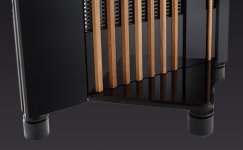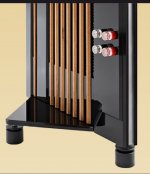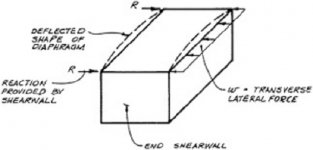Good example of just trying to live with something and make the best of it verses theory.I insulated my speakers with thick rubber feet and the glass wall behind the speakers affected the sound less. Also the rattling from the interior on sidewalls also diminished. The floor is a bouncy wooden frame floor so feet had a dramatic effect. I think spikes should be used on floors directly connected to ground. The rattling from interior is usally a much bigger problem than the very small audible difference spikes makes, at least that has been my experience with big speakers.
My old house had terrible bouncy floor, but mostly in one spot.
I flipped the room around and 80 percent of my problems went away.
Speakers liked being near outer wall, and not near stairwell opening and possible cut joist for cold air return.
Just found this product/claim that matches my experiences in over exciting an already bouncy floor.
Auralex SubDude-HT Subwoofer Isolation Riser
Auralex SubDude-HT Subwoofer Isolation Riser - Free Shipping – True Sound Control
Looks to be for those NOT concerned with subwoofer enclosure resonances (or actual movement of enclosure), it's for those concerned with having their floor sing with the music like a giant passive radiator.
Like I've been exploring with my latest posts, there are architectural consequences of energizing rooms, the sound does not stop at the floor plane, it is just one of many points of energy transference.
Auralex SubDude-HT Subwoofer Isolation Riser
Auralex SubDude-HT Subwoofer Isolation Riser - Free Shipping – True Sound Control
The design features a functionally inert 3/4", velour-covered, MDF platform supported by a 1" base layer of Auralex Platfoam as an isolation boundary to decouple the subwoofer from the floor. This combination of materials diminishes structural vibrations resulting in cleaner and tighter bass, reduced coloration, and a more accurate low-frequency response.
Looks to be for those NOT concerned with subwoofer enclosure resonances (or actual movement of enclosure), it's for those concerned with having their floor sing with the music like a giant passive radiator.
Like I've been exploring with my latest posts, there are architectural consequences of energizing rooms, the sound does not stop at the floor plane, it is just one of many points of energy transference.
Last edited:
Kal Rubinson gave the Auralex Subdude a highly favourable review in Stereophile a number of years ago. I am using Auralex MoPads under my subs, which are thicker foam pads with no platform, designed for isolating monitor speakers. My subs only weigh 50 lbs each, so not more than some monitors.Just found this product/claim that matches my experiences in over exciting an already bouncy floor.
Auralex SubDude-HT Subwoofer Isolation Riser
Auralex SubDude-HT Subwoofer Isolation Riser - Free Shipping – True Sound Control
Looks to be for those NOT concerned with subwoofer enclosure resonances (or actual movement of enclosure), it's for those concerned with having their floor sing with the music like a giant passive radiator.
Like I've been exploring with my latest posts, there are architectural consequences of energizing rooms, the sound does not stop at the floor plane, it is just one of many points of energy transference.
I have IsoAcoustics ISO-200 stands under my monitors, sitting on top of large wooden chests. The isolation is indispensable in this situation. IsoAcoustics also makes a sub stand:
ISO-200sub Acoustic Isolation Stand for Subwoofers | IsoAcoustics
Last edited:
IsoAcoustics also makes a sub stand:
ISO-200sub Acoustic Isolation Stand for Subwoofers | IsoAcoustics
Holy cow that looks like it would be effective.
Gotta be expensive.
I could have used one of those under my turntable in it's original bouncy floor location. I later moved it.
If you have a fireplace in your room, put the TT stand on the hearth extension, mine was brick and very solid.
If your wife allows for it, mount a shelf on the fireplace but do not drill the brick, go though the grout joints - they can be filled later once anchor bolts are removed.
I think one of my Martin/Logan friends tried to put his Sunfire subwoofer inside the fireplace opening one afternoon. I don't recall what happened but the sub ended up behind his listening position where it was a tiny bit delectable, and then out of the system altogether.
Last edited:
I'll add my two cents about speakers.....
Those "spikes" are maybe perhaps useful if the speaker cabinet is on thick carpeting, providing some stability..... that's all.
Any blabber about improving the sound is worthless talk, in the minds of people who don't understand the laws of physics.
Otherwise, a set of cushioned feet on a wood floor is good to prevent marring the cabinet and floor.
Don't allow yourself to buy into all the the hype about spikes - they're just another marketing gadget designed to suck money from people, like Monster Cables, cable lifters, and all that other "audiophile" BS sold today.
Those "spikes" are maybe perhaps useful if the speaker cabinet is on thick carpeting, providing some stability..... that's all.
Any blabber about improving the sound is worthless talk, in the minds of people who don't understand the laws of physics.
Otherwise, a set of cushioned feet on a wood floor is good to prevent marring the cabinet and floor.
Don't allow yourself to buy into all the the hype about spikes - they're just another marketing gadget designed to suck money from people, like Monster Cables, cable lifters, and all that other "audiophile" BS sold today.
To be fair and clear, there is another type of footer, actually two types not to be overlooked and rightfully condemned.I'll add my two cents about speakers.....
Those "spikes" are maybe perhaps useful if the speaker cabinet is on thick carpeting, providing some stability..... that's all.
Any blabber about improving the sound is worthless talk, in the minds of people who don't understand the laws of physics.
Otherwise, a set of cushioned feet on a wood floor is good to prevent marring the cabinet and floor.
Don't allow yourself to buy into all the the hype about spikes - they're just another marketing gadget designed to suck money from people, like Monster Cables, cable lifters, and all that other "audiophile" BS sold today.
(1) The threaded metal stem rod with hard plastic foot pad used as a temporary measure in order to get the right room placement. I'm not sure if Martin Logan is the only company that provides such equipment, but it does come in handy until the woofers break in and as you experiment with on how far out from the front wall you need to go. Once those feet were replaced with the second set of provided spikes there was a huge improvement, and another substantial improvement when I purchased from M/L an even larger heavier set of metal cone feet.
And this is the big "HOWEVER" that I'm complaining about, each step I took to control bass energy was successful. Successful in transferring energy to the sprung floor which in turn set off a new set of problems and subsequent solutions that included DIY Brightstar sand boxes and concrete patio pavers on rubber pads.
(2) Casters and wheels, I see them under some super expensive speakers and even audio equipment racks. I understand that these are usually audio show conditions or dealers rolling in and out new equipment in their most favorable listening room, but I bet someone somewhere sees it and says hey, that's a good idea. It isn't, and if you do NOT trust some Internet guy's opinion, conduct an experiment and compare to your other options. If I'm wrong and you are right, then feel good about me being wrong and enjoy your roly poly existence.
Peter Griffin Family GIF - Find & Share on GIPHY

Last edited:
To be fair and clear,...
Post hoc ergo propter hoc
.... which would probably apply to a great many of the anecdotes in this thread
B.
Rather than fallacies running amok, look at our bantering as theories in development based on personal experience and observation. 😀Post hoc ergo propter hoc
.... which would probably apply to a great many of the anecdotes in this thread
B.
Post hoc ergo propter hoc
Yep, you made me look that one up, so I am learning something. 😉
EDIT:
Earlier I posted :
I think one of my Martin/Logan friends tried to put his Sunfire subwoofer inside the fireplace opening one afternoon. I don't recall what happened .........
I remember now, he said that his wife came out of the bedroom in terror that an aircraft or something just plowed into the roof of the house and the chimney was falling down on them.
Scared the heck out of her. Knowing my friend I think he got a big kick out of it.
He's divorced now too. 😱
Last edited:
A few images from the Alsyvox website. If anyone finds a subwoofer with similar stock feet, please post the images and link.
Our Technology - Alsyvox
Our Technology - Alsyvox
Heavy gauge steel is used for the structure and it is keeping the distortions related to the frame at the minimum, with the help of the considerable total weight and of our proprietary inertial feet that keep the energy reflected by the constraint to the floor as small as possible.
Attachments
Last edited:
I found a review of something along this vein of thought.
SVS SoundPath Subwoofer Isolation System Review
David Vaughn | Aug 9, 2016
SVS SoundPath Subwoofer Isolation System Review | Sound & Vision
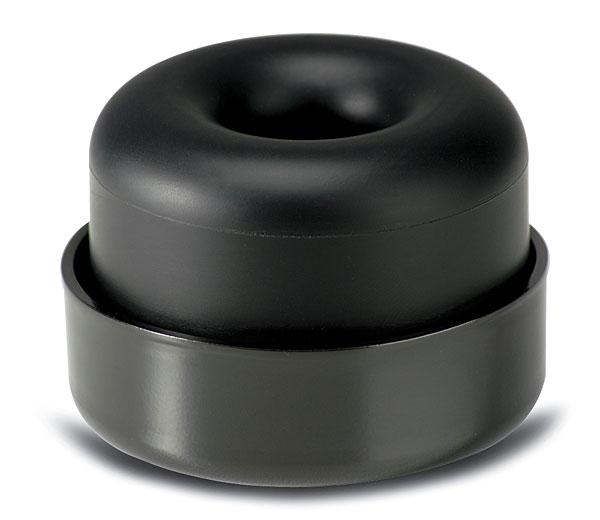
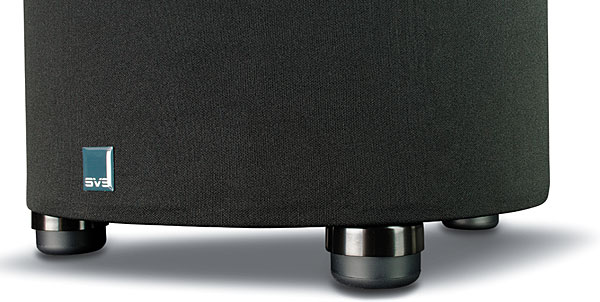
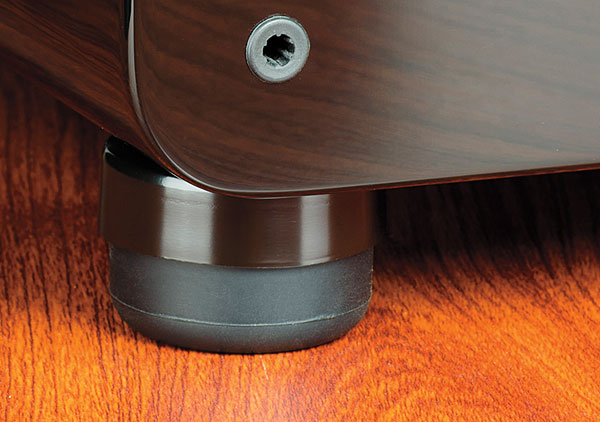
The review seems to be focused on Wife Annoyance Factor, and that he can play it louder without upsetting her.
Not much in there about sound quality or room affects other than things shaking or not shaking around the house.
Author will not be winning this year's Nobel Prize in physics.
SVS SoundPath Subwoofer Isolation System Review
David Vaughn | Aug 9, 2016
SVS SoundPath Subwoofer Isolation System Review | Sound & Vision


When subwoofers are pounding away, they create a lot of mechanical energy that has to go somewhere. When they are in contact with your floor, that energy transmits directly into the substrate. If the sub is on concrete, this isn’t an issue because the concrete is solid and dense. That’s not the case with a wood subfloor. It absorbs that energy and creates floor resonance, which in turn can cause unwanted buzz or rattle in the room, which can lead to complaints from significant others or worse, neighbors in adjoining spaces....................
.........The kit is made up of screw-on replacement feet that swap in for your sub’s existing supports. They’re described as “elastomer isolation feet”—essentially rubber or a rubber-like compound..........

PRICE $50
AT A GLANCE
Plus
Easy to install
Tames unwanted vibrations
Minus
Why aren’t these standard issue?
THE VERDICT
If you have touchy neighbors who complain about vibrations from your subwoofer, you need these in your system.
The review seems to be focused on Wife Annoyance Factor, and that he can play it louder without upsetting her.
Not much in there about sound quality or room affects other than things shaking or not shaking around the house.
Author will not be winning this year's Nobel Prize in physics.
SVS Soundpath Subwoofer Isolation System Review (Fewer Rattles, Cleaner Bass) Turntable suggestions?
YouTube
<iframe width="560" height="315" src="https://www.youtube.com/embed/MiJvfL15rXc" frameborder="0" allow="accelerometer; autoplay; encrypted-media; gyroscope; picture-in-picture" allowfullscreen></iframe>
Don't be surprised if you have to turn the subs down a little after installation. I had to turn the sub trim on the AVR down by .05 to 1.0 db to get it back to the same level, but my wood floor sucked up a lot of bass energy, so your experience may vary.
Curious that one reviewer said he could turn the subs up more, but the video guy had to turn them down to balance because the floor was no longer soaking up all the bass.
And from Research Gate.
Vibration isolation systems: a) Machine bolted to a rigid foundation,... | Download Scientific Diagram

Passive vibration isolation is a vast subject, since there are many types of passive vibration isolators used for many different applications. A few of these applications are for industrial equipment such as pumps, motors, HVAC systems, or washing machines; isolation of civil engineering structures from earthquakes (base isolation), sensitive laboratory equipment, valuable statuary, and high-end audio. A basic understanding of how passive isolation works, the more common types of passive isolators, and the main factors that influence the selection of passive isolators. [5] Common Passive Isolation Systems: Pneumatic or Air Isolators:...............
Pads or sheets of flexible materials such as elastomers, rubber, cork, etc. Cork and/or elastomeric pads are often used under heavy machinery or even under audio systems. Molded and Bonded Rubber and Elastomeric Isolators and Mounts: These are often used as machinery mounts or in vehicles. They absorb shock and attenuate some vibration. Negative-Stiffness Isolators: Negative-stiffness isolators are less common than other types and have generally been developed for high-level research applications such as gravity wave detection.
Vibration Control/Isolation
Vibration Control Theory - Active & Passive Shock - Farrat

A condition should be achieved where the amount of vibration transmitted from or to the machine is at an acceptable level.
I agree with that quote above.
Damping provides energy dissipation in a vibrating system. It is essential to control the potential high levels of transient vibration and shock, particularly if the system is excited at, or near, to its resonant frequency.
The 6 Best Subwoofer Isolation Pads and Risers For Your Home Studio
Did you know that crappy speakers in an acoustically treated room can sound better than high-end monitors in an untreated room?
You wouldn’t believe how much impact good isolation can have on the sound quality of your speakers or subs!
Speakers and Subwoofers produce vibrations and resonant energy. If they are not properly isolated, these vibrations will be transmitted to your walls, floors, and ceilings.
Which leaves you with a muddy bass … and angry neighbors!
Subwoofer Isolation pads reduce these vibrations by decoupling your sub from the structure it rests on.
They will not only improve bass performance and eliminate room rattle, they will also provide a cleaner, tighter bass while reducing floor and wall vibrations, noise artifacts and complaints from neighbors or roommates.
Therefore, your subwoofer’s performance will be instantly improved and the accuracy of the original audio track preserved.
The sound transferred through the floor is minimized, resulting in reduced coloration, and a more accurate low-frequency response.
In another forum.
Any experience with subwoofer isolation stands?
Any experience with subwoofer isolation stands? | Steve Hoffman Music Forums
The 2nd effect that is mitigated is the wave destruction that occurs when a sound wave from the speaker cone interacts with the energy that is traveling through the floor. Real world physics prevent is from isolating and hearing the sound that is transmitted from the floor back in to the room. If you can imagine being able to isolate the bass that is being produced by the vibration in the floor itself without the direct sound you hear from the sub, you can imagine it would be similar to the bass you hear in the next room. Eliminating that 2nd bass source in the room helps to prevent smearing, nodes and wave cancellation. It's not only loosing sound through the floor but having sound coming from a secondary source unintentionally.
Yea, I want to hear the subwoofer, not the sprung wood floor resonating sound like a giant speaker diaphragm.
In my old house with wood floor I built a very large/deep Brightstar type sand box for under the subwoofer. It helped but in retrospect, should of had some rubber feet under that box in addition to the mass.
Last edited:
Another consideration?
Yamamura RIP | What's Best Audio and Video Forum. The Best High End Audio Forum on the planet!
Yamamura RIP | What's Best Audio and Video Forum. The Best High End Audio Forum on the planet!
Then put high density graphite under my Soundlab speaker and sound was more clean and bass more controlled.
I have a little explaining to do about one of the terms I just sort of threw out there.
Diaphragm (structural system)
Diaphragm (structural system - Wikipedia)
So when I call the wood floor system a "diaphragm" know that it is an element very much intended to transfer lateral (sideways) forces.
You might need to picture this, see below.
As an architect with over 30 years experience it's nice to be able to bring some of my old college studies into my audiophile hobby.
PDF
Diaphragm (structural system)
Diaphragm (structural system - Wikipedia)
In structural engineering, a diaphragm is a structural element that transmits lateral loads to the vertical resisting elements of a structure (such as shear walls or frames). Diaphragms are typically horizontal................
The diaphragm of a structure often does double duty as the floor system or roof system in a building, or the deck of a bridge, which simultaneously supports gravity loads.
So when I call the wood floor system a "diaphragm" know that it is an element very much intended to transfer lateral (sideways) forces.
You might need to picture this, see below.
As an architect with over 30 years experience it's nice to be able to bring some of my old college studies into my audiophile hobby.
Attachments
Last edited:
Read this today and thought it applies to the topic.
Membrane Absorbers - SoundBridge
Membrane Absorbers - SoundBridge
It is also useful to know that wood floors on joists, which are, of course, membrane absorbers, can produce additional drum sounds ...........
- Home
- Loudspeakers
- Subwoofers
- Spikes or Isolators under subs?
